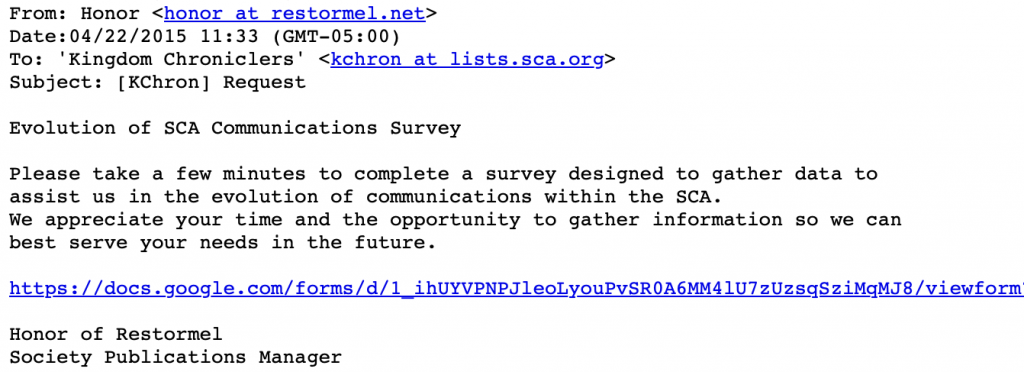The SCA has a legitimate interest in avoiding confusion around its policies that could be caused by the widespread publication of incomplete or out-of-date documents. To further this goal, it instructs officers in kingdoms and local branches to link to the canonical documents on SCA.org rather than hosting copies on their own websites — this way, there’s no chance that someone might be misled by reading an old copy of Corpora or an office handbook that has been since been superseded.
But I wanted to make sure that this policy would not be construed in such a way as to prevent amateur historians of the Society from sharing and discussing old versions of these documents, so I penned an inquiry to the Society’s leadership.
Reassuringly, I’ve received an answer from the Society President stating that these are “public documents” and may be shared as long as steps are taken to minimize the chances of confusion.
Correspondence on this topic is appended below.
From: Mathghamhain Ua Ruadháin
To: Society Seneschal
Cc: Society In-House Counsel, Society President
Date: 18 August 2023
Greetings from the East,
I have a policy-related question that I hope you can help with: would any harm be caused by sharing an archive of previous editions of the Society’s governing documents?
I ask because the following sentence appears on the front page of the Organizational Handbook: “The contents of this document will be posted at http://www.sca.org and further reproduction on other Internet sites is expressly forbidden.”
I assume the prohibition stems from a concern that having multiple copies of the governing documents floating around on various websites could cause confusion if someone were to refer to an out-of-date edition that had been posted to some third-party location.
However, given the interest in possible revisions to Corpora and the Bylaws, I think there is a real value to our membership in making earlier versions of the governing documents available for easy reference so that people can see what has changed over time.
Therefore, I have collected a batch of sixteen historical versions of the organizational handbook from the last two decades, and would like to post them for public review. Before doing so, I plan to watermark each page by overlaying a message that clearly indicates that this is a non-canonical document for historical reference only, and directing people to visit SCA.org to obtain the current governing documents.
Can you see any way in which this would harm the interests of the Society?
Thank you for your consideration,
— Mathghamhain Ua Ruadháin
From: Mathghamhain Ua Ruadháin
To: Society Seneschal
Cc: Society In-House Counsel, Society President, Board Ombudsman for Corporate Office
Date: 23 September 2023
Hello,
I’m checking in because a month has passed without a reply to this question.
Would any harm be done if I posted an archive of old versions of the Society’s governing documents, clearly labeled to show they were out of date and for historical reference only?
Thank you,
— Mathghamhain Ua Ruadháin
From: Society President
To: Mathghamhain Ua Ruadháin
Cc: Society Seneschal, Society In-House Counsel, Board Ombudsman for Corporate Office
Date: 25 September 2023
Hello Matthew,
We very much appreciate your interest in this area and concur with your basic analysis. We feel that the risk of confusion from having the old versions published may possibly outweigh the value of being able to look at the evolution. There is a concern that someone may look at an outdated version of one of our documents and rely on a section that has since been amended. But all of these versions are public documents and as such are in the public domain.
It is appreciated that if you do put these up that all of the past versions are clearly marked as such and that wherever the placement is done that area be clearly designated as not an official site of SCA, Inc.
Your watermark plan should help prevent any confusion.
In service,
John

